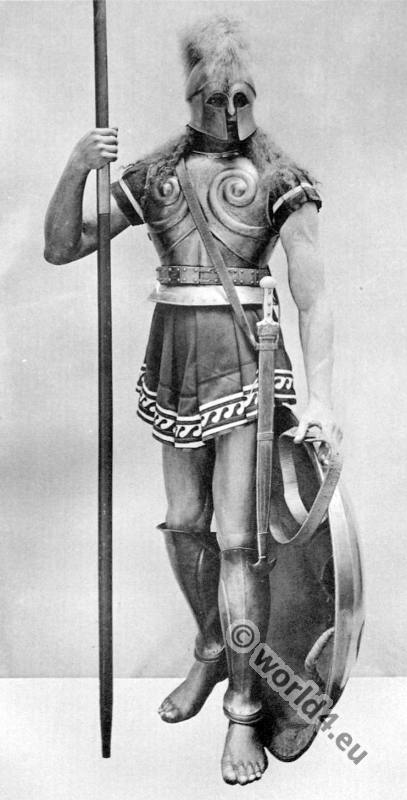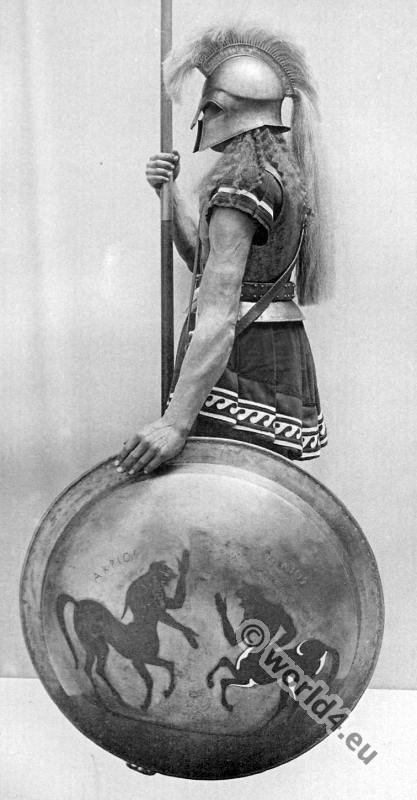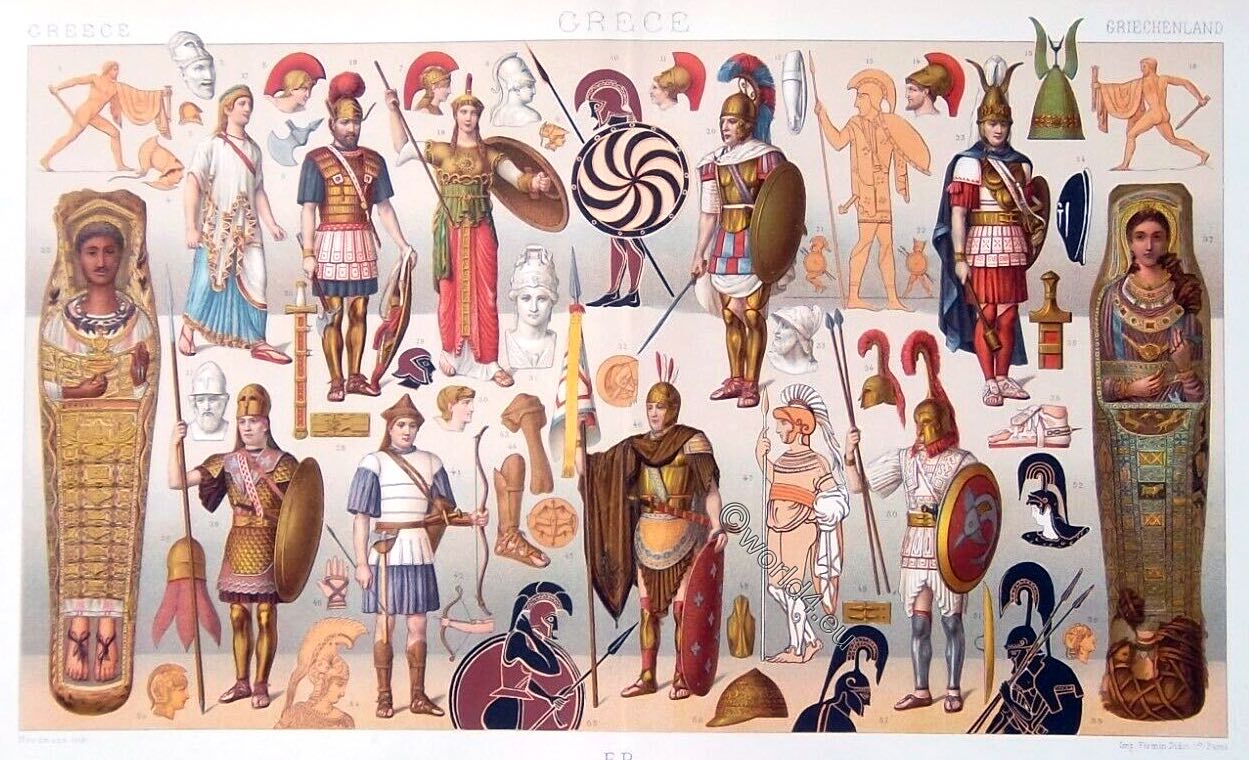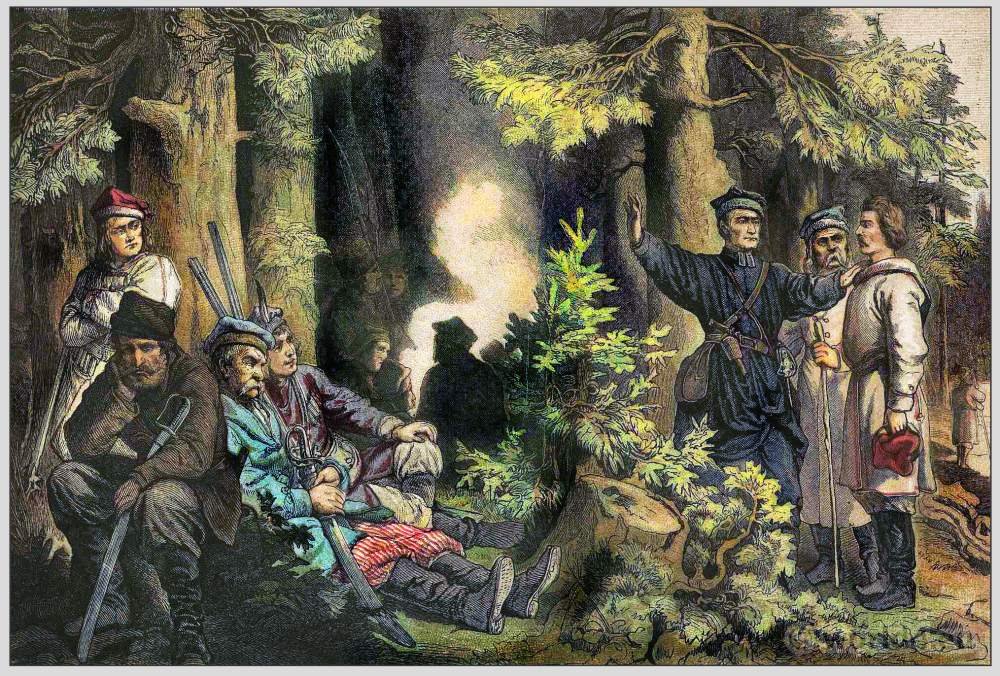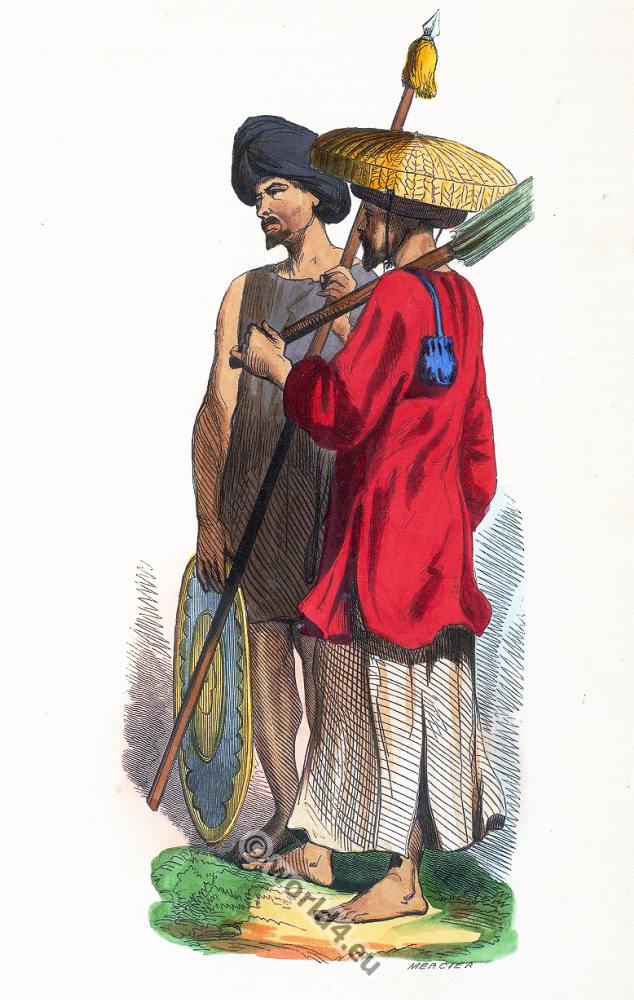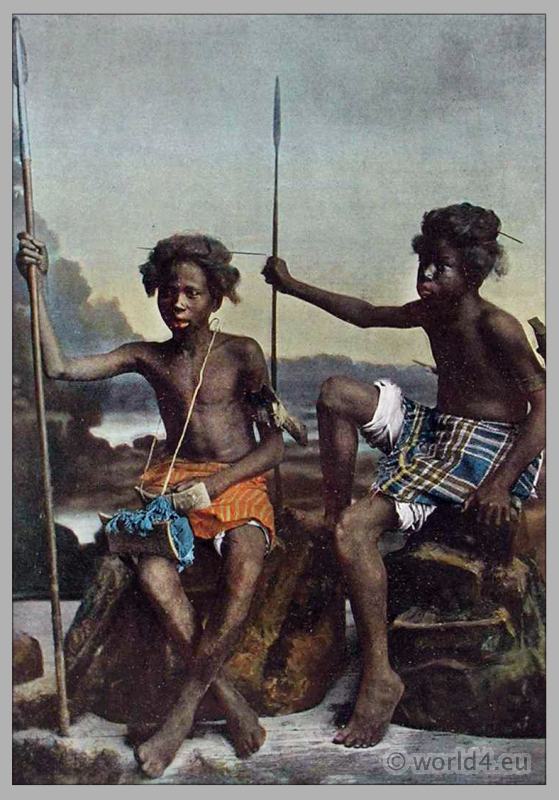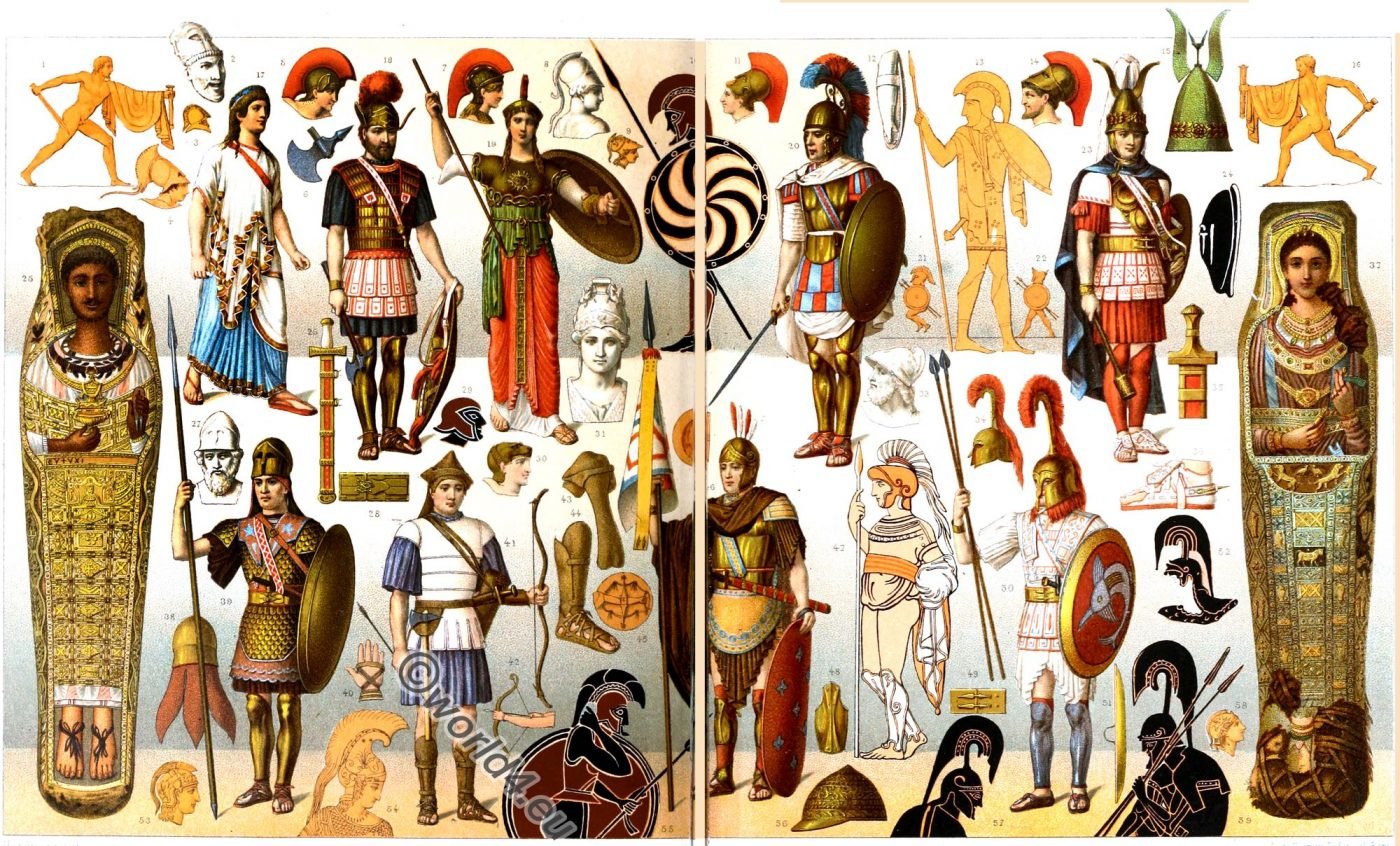
Double Plate.
GREECE.
WARRIORS OF HEROIC AND HISTORICAL TIME. LEADERS AND SOLDIERS. THE HOPLIT, THE PELTAST, THE RIDER, THE PHALANGIT, THE VICTORIOUS WARRIOR, THE ARCHER. THE GREAT GODDESSES OF WAR AND HUNTING, ATHENA AND ARTEMIS. THE PURPURE. BOURGEOIS COSTUME AT THE TIME OF THE PTOLEMY.
The armament of the heroic period is here, mainly after vase paintings, combined with that of the historical one. The latter are numbered 18, 20, 23, 39, 41, 46 and 50, as they were formed as a result of the reforms of Iphikrates, died 348 B.C., after the reconstructions of the Director of the Artillery Museum in Paris, Colonel Leclercq (Auguste Bouché-Leclercq). Reproductions of statues of Athena and Artemis are attached, because these deities can be regarded as representatives of the warlike crafts of the Greeks.
No. 18. The warrior. Nos. 6 and 25. Details of his armament.
The armor of this warrior is reconstructed from the statue of Mars in the Vatican. The breastplate is made up of bronze plates attached to leather cords and has its extensions in a double hip apron made of leather strips. Wide armpits of bronze plates hold the armour, under which a linen tunic with short sleeves is worn. Helmet with low comb, open visor and cheek flaps. – Leathered hanger (cf. sword with ivory handle No. 25); bronze greaves. Corded sandals with red soles. Iron battle axe with leather covered handle. Wooden round shield with small bronze plate on a hanger with cross rails for arm and hand. On the inner surface several red tassels, the use of which is explained in No. 45. No. 32 shows the way the shield was worn before the battle (cf. No. 12). The Greeks borrowed the use of the shield strap from the Carians. No. 5 and No. 55 give examples of helmets of the heroic period.
No. 20 – The hoplit or heavily armed (ancient Greek ὁπλίτης hoplítēs).
Arming of the Hoplites. The Panoplie. Bronze helmet with wide cheek flaps fastened under the chin. High helmet cap with openwork comb and horsehair bush. The breastplate was made of the body forms; hip apron, leg splints and shield were also made of bronze. Tunic aproned on both sides. The breastplate is laced under the arms, enclosed by a belt and held by armpits. The upper arm is protected by leather strips. The slightly bulged round shield (ασπίς aspís) is without hump and badge. A strong, corded sandal serves as footwear.
The attack weapon is the Greek double-edged sword, with bronze handle. The scabbard, covered with leather and reinforced with bronze plates, hangs on a leather bandelier that runs under the belt. The light linen coat is thrown back and served as a defence after losing the shield, wrapped around the left arm. According to individual passages of the xenophone, the common hoplit did not wear a breastplate, which was a privilege of the leaders.
As side pieces of the Hoplite helmet from the heroic time serve No. 5, 10, 29 and 55.
Nos. 1 and 16 show how the coat wrapped around the left arm was used for defence. Nos. 21 and 22 give examples of the warlike walking and jumping of the heavily armed.
No. 50. The Peltast or lightly armed, (πελτασταί, peltastaí).
No. 34 and 49 details of its armament.
Peltae was an old and famous city in northern Phrygia; Peltae as the name of the small Amazon shield indicates the origin of this defensive weapon. It was worn by the Peltasts who were ranked by Iphikrates among the regular troops.
The Peltast depicted here wears a quilted leather and wool armour, held by pieces of armpit, leaking into a hip apron and surrounded by a belt of hammered bronze. Underneath a pleated tunic. Tinnet leg splints pulled over a kind of woolen calf stocking. The wooden round shield is painted and carries a silver fish as badge. The sword hangs on a narrow leather band. At the javelins is the amentum, a leather strap, in which one put two fingers while throwing the same. The bronze helmet with firm nose protection and cheek flaps is the boeotic one; it carries a raised comb with hair bush. The footwear is the sandal held by straps with the agraffe, the sign of the free man, over the instep.
Similar helmets from heroic times can be found under no. 52, 57 and 59.
No. 23. – The rider, (Hippeis, ἱππεῖς) . Details of his armament no. 35 and 36. Figure after a Greek vase painting. The original armor is in the Museum of Naples.
The Greeks used neither stirrups nor saddles and seem to have hardly used the blanket of the Roman horseman.
The following armour is made of leather, continues in a short hip apron and is surrounded by a wide bronze belt with double aagraffe. The armpits protect the shoulders and upper arm at the same time. The armour is reinforced by wide bronze discs. The woolen tunic is pleated like No. 50, as is the sleeve. The Etruscan helmet with high horns and back fluttering bush resembles the green bronze helmet in the Louvre shown under no. 15. Both are decorated with a laurel wreath and seem to be parade helmets.
The greaves are made of leather; the small shield hangs on a strap; a spur is attached to the sandal (see No. 36). The weapons used are a sword (cf. no. 35) and a bronze mace. The wrist is decorated with a bracelet. In addition there would be a lance or two javelins.
No. 39. The Phalangit (pezhetairo’s companion on foot). No. 28 and 39. Details of his armor. Restitution after a grave in Florence. Helmet with open visor in the shape of a human face, over a leather cap, the hanging continuation of which serves as neck protection (cf. No. 38). Scale armour drawn on leather over a woolen tunic with armpits, held over the shoulder by leather stripes and enclosed by a bronze belt with double aagraffe. Bronze leg splints. Sandals with leather straps. The sword with wooden handle and leather sheath hangs on a bandelier. The round wooden shield, with bronze plating, without hump, is fastened with a strap around the neck. The lance with iron tip and foot iron is not as long as the Macedonian Sarissa of 5-7 m length.
The Macedonian phalanx found its model in the reforms of the Athenian generals Iphikrates (around 415 BC; † around 353 BC) and Chabrias (disciple of Plato, Greek Χαβρίας Chabrías; † 357 BC).
Helmets with the human face reproduced, movable or immovable visor from heroic time are shown under No. 2, 4, 8, 9, 11, 14, 27 and 33.
No. 46. Victorious warrior. Detail of his armour no. 48. Illustration after a mural painting found in Pästum.
He wears a helmet with neck guard, open visor, four feathers in sleeves and movable cheek flaps in hinges. Bronze breastplate, high girdled, over a strong leather stool, adjoined by a semicircular apron. Red dyed calf stocking made of leather with bronze half splint and protection for the heel. The shape of the latter shows that the warrior is a rider. The short shoulder pieces of the tank are made of leather.
The tunic is pleated so that it can be pushed forward from the hips by a slight movement. The large wooden shield is painted and decorated with iron rosettes. The coat is the chlamys. The shape of the sandals seems to correspond to the one Iphikrates introduced and which was still called iphicratides at the time of Diodorus Siculus.
As weapons serve sword and lance. At the tip of the latter the warrior wears the leather belt and the painted tank of a defeated enemy.
For the shape of the helmet see No. 5, 7, 13, 31, 47, 53 and 58, heroic period.
No. 41. Archer. Details of his armour no. 43 and 44.
After the figures in the pediment of the temple of Aegina. Leather cap with long neck guard (see no. 43). Leather armour over a woolen tunic. Leather greaves, consisting of two parts and connected to the sandal (see no. 43). Bow, composed of two horn parts. Bronze bracers to protect against the rebound of the tendon. Leather quiver hanging on the side and attached at the back. Sword and battle axe.
No. 42 shows the stretched arch of a Phrygian from the temple gable of Aegina.
No. 19. Pallas Athene, statue in Dresden: restoration.
She is depicted in fighting posture. The Aegis, made of the fur of the goat Amalthea, covers her breast. According to Herodotus, this peculiar armour form derives its origin from a garment of the Lybians, which was covered with leather instead of snakes. Probably such a harness was once really in use.
The helmet of Athena changes after the localities. Cf. no. 52 and no. 54.
Also the large bronze shield finds its analogies in no. 10. Cf. no. 12 and 24.
No. 17 – Artemis, the so-called Diana of Herculaneum.
This statue shows the way the Greeks painted their sculptures. Gilded hair, white diadem-shaped bandage with gilded rosettes. Tunic with reddish stripes. Peplos, whose border consists of a fine golden net and a wide red stripe with white palmettes. The straps of the sandals and quiver are red with white dots.
No. 40 – Hand with the Cestus (a kind of antique brass knuckles from the Latin caedere “strike”. Leather strap with metal thorns).
This type of armament consists of leather straps wrapped around the hand and wrist, sometimes reaching up to the elbows and covered with lead or metal nails. The fistfight was one of the gymnastic games used as a preliminary exercise for the war. As injuries and even deaths became more and more serious the Cestus was banned from the Olympic Games in 30 AD. The sport was particularly highly regarded in Greek antiquity because of its dangerous nature. The most famous fistfighter of antiquity with over 1000 prizes was Theogenes of Thasos (480 BC).
Dubois Maisonneuve says civilized peoples used to paint the objects they wanted to make scary with red, the color of blood. The nature of red, which is used for warlike costumes, can be divided into different epochs. There were two types of purple, the animal and the vegetable. The former was purple, the latter scarlet. The vegetable purple seems to have been used first.
The coccus, which Pliny calls the fruit of a shrub, seems to have been an insect, the cochineal or scale insect, which produces a scarlet purple.
The porphyra was fished on the coasts of Africa and Lakonia, especially around Tyrus. The purpura pelagia provided the most intense and durable color.
The Taeniensis was the brightest. The name seems to indicate that it was preferably used for the sanitary towels, tänien.
The Purpura Calculensis, fished on stony seabed, was also of good quality.
The red of the Buccina, a smaller purple snail, was bright; mixed with dark purple, there was a beautiful cherry red.
If a fabric previously dyed with coccus was redyed with Tyrian purple (Scale insect Dactylopius coccus), a colour called hysginus was obtained, a kind of ponceau.
The black purple, melamporphymn was worn by the aged in comedy. Coccobaphes were called the fabrics dyed with coccus, hydrobaphes and psychobaphes the cold dyed ones, as they are still produced in India today. Garments with a lower purple rim were called porphyrosemos; the tunic decorated with a vertical stripe from top to bottom was called mesoporporphyra.
No. 25 and 32. Civil dress. Greeks from the time of the Ptolemies, mummified in Egyptian manner.
These two mummies were brought from Egypt by Pietro della Valla and are published by G. Becker in his description of the ancient monuments in Dresden.
The man has curly hair, moustache and sideburns. His head rests on a pillow with embroidered edge. A tiara set with precious stones reaches both sides to the height of the ears. His clothing consists first of all of a long robe with red, grey and white stripes, above and below with a regularly divided thrust. At the height of the sternum a laurel wreath as it seems embroidered. The Egyptian apron is decorated in its entire width with a symbolic sun. In the middle the bust of Osiris, on both sides the unfolded wings of Isis, whose profile is turned outwards. The whole is surrounded by the symbols of Harpokrates, Anubis and other genii. A horizontal stripe bears an inscription, an obituary directed to the dead, such as: “Be happy” or “Fear Nothing”.
The overgarment over the white robe is extraordinarily splendid. It is a kind of dalmatica made of metal plates sewn onto the fabric. Each plate contains a symbolic representation, a bird, wing figures, twigs, plants, etc.
The papyrus sandals are fastened with strings of plant fibres. Golden chains and rings decorate neck and fingers. The right hand holds a golden vase, the left hand a phallus.
The woman’s head rests on a pillow decorated with pearls. The artificially curled hair is surrounded by a diadem, in the middle of which a lotus flower with a coloured stone rises, while three other stones fall freely on each side.
The sleeve robe is pulled over a white undergarment, the neckline of which can be seen. She is purple and regularly pleated. On both sides there is a green stripe. The collars are numerous. (One distinguishes the deraia at the upper, the hypoderaia at the lower part of the neck; the perideraia and peritrachelia enclose the neck, the maschalisteres hang down on the chest). Both wrists are decorated with bracelets. The right hand shows two rings on the ring finger, the fingers of the left hand are all decorated with rings. The right hand holds a vase, the left the leaf of a holy plant with fruit. Egyptian apron and footwear are the same as for No. 25.
No. 18, 20, 23, 39, 41, 46 and 50 and the details No. 3, 25, 28, 34, 35, 36, 38, 43, 44, 48 and 49 belong to the collection of the Artillery Museum in Paris. Photographs are coloured according to the originals.
Nos. 17, 27, 31 and 33 also according to photographs.
No. 8, 12, 19, 25 and 37 are taken from the description of the ancient monuments in Dresden published in Leipzig.
No. 15 and 56 are drawings after the originals in the Louvre.
No. 5, 7, 11, 14, 30 and 42 are coloured after the restoration by Charles Garnier, also Athena No. 19.
No. 2 is a fragment of the Temple of Selinunte.
No. 1, 4, 10, 13, 16, 21, 22, 24, 29, 32, 45, 52, 54, 55 and 59 are fragments of vase paintings, the Musée Napoleon III by Adrien de Longpérier, the Monuments inédits d’antiquité grecque by Raoul Rochette, the monuments of O. Müller and Wieseler and so on.
No. 3, 9, 40, 53 and 58 are medals taken from the same works.
See Philostrates, About Gymnastics. – Plutarchos, life of famous men. – Thucydides, History of the Peloponnesian War.
Source: History of the costume in chronological development by Auguste Racinet. Edited by Adolf Rosenberg. Berlin 1888.
Related
Discover more from World4 Costume Culture History
Subscribe to get the latest posts sent to your email.

